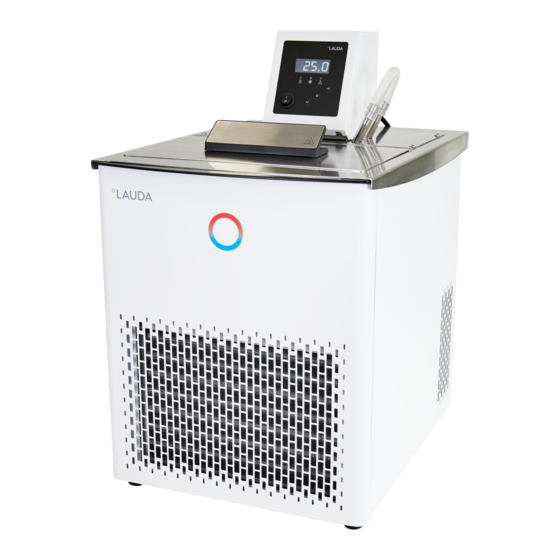
Summarization of Contents
Safety Notes
General Safety Notes
Discusses general safety precautions for operating LAUDA thermostats, including intended use and qualified personnel requirements.
Other Safety Notes
Details specific safety precautions like checking for shipping damage, handling hot parts, and connecting to grounded power.
Unit Description
Environmental Conditions
Specifies the allowed operating conditions for LAUDA thermostats, including indoor use, altitude, temperature, and humidity.
Types of Unit
Explains the designation system for Alpha thermostats, differentiating between heating (A) and cooling (RA) units and bath volumes.
Baths
Details the bath vessel specifications, material, volume, and mounting options for the thermostat clamp.
Pump
Describes the centrifugal immersion pump, its motor, outflow connection, and the use of an outflow reducer.
Materials
Lists materials used for parts exposed to heat transfer liquid, emphasizing stainless steel and temperature-resistant materials.
Temperature Indication, Control and Safety Circuit
Explains the LED display, user interface, temperature probe, and control algorithms for heating and cooling.
Refrigeration System
Details the refrigeration system components, operation, air circulation, and compressor sensors.
Standard Accessories
Lists standard accessories provided with cooling and heating units, and optional accessories available.
Preparations
Assembly and Setting Up
Provides instructions for placing the unit, attaching pump outflow reducers, and fixing circulation sets or cooling coils.
Filling and Emptying
Details how to fill the bath with heat transfer liquid to the correct level and how to safely empty the unit.
Heat Transfer Liquids and Hoses
Lists approved heat transfer liquids (Aqua 90, Kryo 30) with specifications and details on suitable tubing types and their applications.
Connection of External Circuits
Explains how to connect external circulation sets for cooling thermostats and accessory sets for immersion/heating units.
Starting Up
Connection to the Supply
Instructs on connecting the unit to a grounded mains power socket, checking voltage, and fuse protection.
Switching On
Guides the user through the initial power-on sequence, including self-test, software version display, and initial bath temperature reading.
General Key Functions and Pilot Lamps
Explains the operation of the control panel keys (Enter, Decrement/Increment) and the meaning of indicator LEDs (heating, cooling, alarm).
Temperature Setpoint Setting
Details how to set the desired bath temperature, including value acceptance and temperature range limits.
Automatic Shutdown Timer
Explains how to activate, deactivate, read, or set the automatic shutdown timer for the unit.
Defining Temperature Limits
Describes how to set maximum (Hi) and minimum (Lo) temperature limits to prevent damage to the medium or apparatus.
Refrigeration Unit Submenu
Explains how to configure the refrigeration system (Auto, ON, OFF) for cooling thermostats.
Offset for the Internal Temperature Probe
Guides on calibrating the internal temperature probe using a reference thermometer and adjusting offset values.
Restoring Works Settings
Details how to reset all settings to factory defaults, excluding probe calibrations.
Standby
Explains the 'Standby' status following a shutdown and how to reactivate standard operation.
Safety Functions
Safety Functions and Removal
Covers how the thermostat triggers alarms, warnings, or errors and how to clear these messages.
Overtemperature and Low Level Protection
Describes the safety mechanisms that shut off the unit if bath temperature exceeds limits or liquid level is too low.
Overtemperature and Low Level Protection Testing
Provides a procedure for testing the overtemperature and low-level protection systems every six months.
Unlock the Overtemperature Protection
Explains the procedure to reset the overtemperature protection after it has been triggered.
Pump-Motor Supervision: Overload
Details the pump overload detection, alarm signals, and shutdown procedures when the pump is blocked or overloaded.
Fault List: Alarms and Errors
Lists common error messages and their meanings, including alarms for over-temperature, low-level, and pump issues.
Maintenance
Cleaning
Provides instructions for cleaning the unit, emphasizing safety precautions like unplugging the mains and avoiding liquid ingress.
Maintenance
Outlines general maintenance procedures, emphasizing the need for qualified personnel for repairs and liquid replacement.
Service Intervals
Lists recommended service intervals for different system parts like the device, heat transfer liquid, and cooling unit.
Testing the Heat Transfer Liquid
Explains how and when to test the heat transfer liquid for contamination and capability for use.
Maintenance of the Refrigeration Unit
Details the maintenance required for the refrigeration unit, specifically condenser cleaning based on ambient conditions.
Note on Repair
Advises on contacting LAUDA Service for repairs and ensuring proper packing if returning the unit.
Disposal Information
Covers disposal regulations for the device, refrigerant, and packaging according to EU directives.
Ordering Spares and Rating Label
Provides guidance on ordering spare parts, quoting instrument type and serial number, and contact information for LAUDA Service.
Declaration of Conformity and Product Returns
Product Returns and Clearance Declaration
Provides a form and instructions for returning LAUDA products, including RMA procedures and clearance declarations.














Need help?
Do you have a question about the A 6 and is the answer not in the manual?
Questions and answers